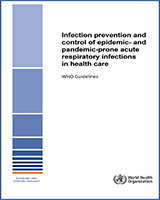Equipment used for respiratory therapy (e.g. items that come into contact with mucous membranes) is considered semicritical1; such items should be cleaned and then receive at least high-level disinfection between patients (225). High-level disinfection of respiratory equipment takes place after cleaning, and is typically accomplished by chemical germicides or physical methods, as outlined below (253).
Chemical germicides
Chemical germicides used for high-level disinfection include (225):
glutaraldehyde-based formulations (2%);
stabilized hydrogen peroxide (6%);
peracetic acid (variable concentrations, but ≤ 1% is sporicidal);
sodium hypochlorite (5.25%, diluted to 1000 ppm available chlorine – 1:50 dilution).
The most appropriate chemical germicide for a particular situation should be selected on the basis of the object to be disinfected, its composition and intended use; the level of disinfection needed; and the scope of the services, physical facilities, resources and personnel available.
Physical methods
Physical methods for high-level disinfection include hot-water disinfection (pasteurization) or steam (e.g. autoclaving at lower temperature). Pasteurization is a non-toxic, cost-effective alternative to high-level disinfection with chemical germicides. Equipment should be submerged for at least 30 minutes in water at a temperature of about 70 °C (less than the temperature that typically damages plastic). Pasteurization can be accomplished using a commercial washer or pasteurizer (254). After pasteurization, wet equipment is typically dried in a hot-air drying cabinet before storage. Steam sterilization is an inexpensive and effective method for sterilization or high-level disinfection. Steam sterilization is, however, unsuitable for processing plastics with low melting points, powders or anhydrous oils. Bacterial spores may survive after high-level disinfection. Microbiological sampling can verify that high-level disinfection has resulted in the destruction of vegetative bacteria; however, such sampling is not routinely recommended.
I.1. Steps for cleaning and disinfection of plastic pieces of respiratory equipment
PPE is required when cleaning or processing equipment and instruments, to protect against splashing, spraying or aerosols.
Wash the equipment with soap (e.g. liquid dish soap) and clean water.
Rinse the equipment completely with clean water.
Disinfect the equipment to inactivate any remaining pathogens.
There are several ways to disinfect equipment, and the products available at the health-care facility should be used. Safe methods of disinfection include:
heat for heat-resistant equipment that can withstand high temperature (e.g. 80 °C); such equipment can be disinfected using a washer–disinfector;
if a washer or pasteurizer is not available, use a high-end or commercial dishwasher with a “sanitize” feature that can reach 70 °C ;
for plastic equipment that may not tolerate 80 °C and for equipment that may be damaged by boiling, or in the absence of the equipment described above, use chemical disinfection (e.g. soak in 1:100 sodium hypochlorite solution for 30 minutes, as described in
Annex G).
- 4.
If using chemical disinfection, rinse with sterile or clean water (i.e. water boiled for 5 minutes and cooled). Sterile water is preferred for rinsing off residual liquid chemical disinfectant from a respiratory device that has been chemically disinfected for reuse, because tap or distilled water may harbour microorganisms that can cause pneumonia. However, when rinsing with sterile water is not feasible, instead, rinse with tap water or filtered water (i.e. water passed through a 0.2 μ filter), followed by an alcohol rinse and forced-air drying.
- 5.
Dry equipment.
Physical equipment (e.g. a washer, pasteurizer or autoclave) often has a drying feature within the machine.
For chemical methods, let equipment parts air dry on a clean towel or cloth.
- 6.
Store equipment dry in closed packages.
Summary: Wash with soap and clean water, rinse, disinfect, rinse (if chemical method), dry and store.
I.2. Cleaning and disinfection of mechanical ventilators
To clean and disinfect a mechanical ventilator, wipe down the controls and entire outside of the equipment with a compatible disinfectant (e.g. sodium hypochlorite solution of 0.05% or 500 ppm for non-metal surfaces).
Disinfect tubing using sodium hypochlorite solution of 0.1% or 1000 ppm, ensuring that the entire lumen of the tubing is flushed (Section I.1, above).
It is not necessary to routinely clean respiratory and pressure lines within a ventilator between patients, because the lines are not exposed to the patient or the patient's respiratory secretions.
Usually, the entire expiratory side tubing is removable (the expiratory end has a valve to control the escape of gas from the circuit and may also have a flow measurement device or a water trap, or both). This tubing should be disassembled and cleaned first with a detergent, rinsed clean, and then subjected to either high-level disinfection or sterilization. High-level disinfection is the minimum required procedure for these items, but due to the practicability of some sterilization methods and health-care facility protocols (e.g. steam), these items can, if suitably designed, be submitted to sterilization.
When mechanical ventilators are used in the care of a patient with an ARI of potential concern, bacterial and viral filters are recommended on exhalation valves.
- 1
According to Spaulding's classification (224), semicritical items are devices that come into contact with mucous membranes or nonintact skin

